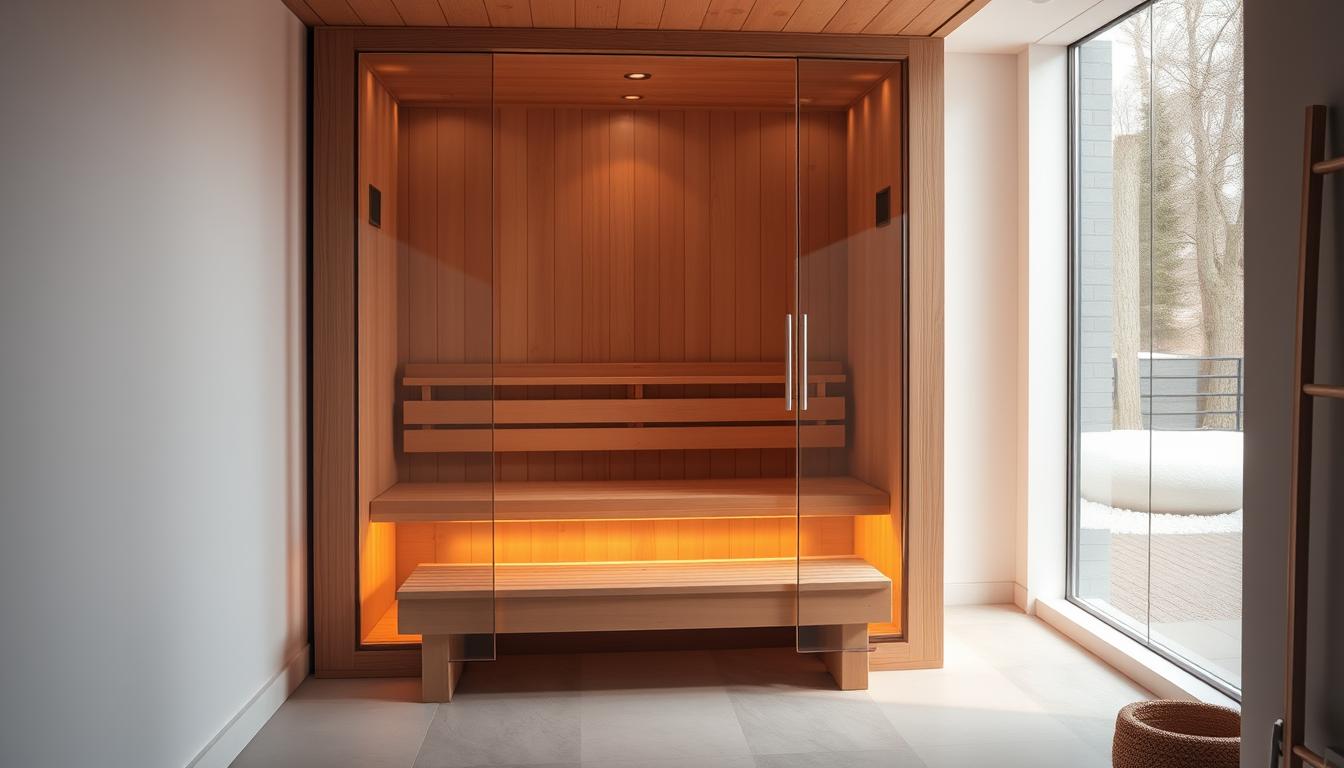
Infrared Sauna Therapy: Unlock Pain Relief and Relaxation
Infrared sauna therapy combines ancient sweat practices with modern technology to offer a unique wellness experience. Unlike traditional saunas, it uses infrared light to heat the body directly, providing deeper penetration at lower temperatures. This approach is gaining popularity for its ability to address chronic pain, aid muscle recovery, and reduce stress.

Dr. Melissa Young from the Cleveland Clinic highlights the benefits of this therapy, emphasizing its role in promoting overall health. Traditional saunas typically operate at 150-195°F, while infrared versions maintain a more comfortable range of 110-135°F. This makes the experience more accessible for those who find high heat overwhelming.
This article explores the evidence-based advantages of infrared sauna therapy. From improving circulation to supporting detoxification, it’s a powerful tool for health optimization. Discover how this modern approach can enhance your wellness journey.
Key Takeaways
- Infrared sauna therapy merges ancient practices with advanced technology.
- It operates at lower temperatures compared to traditional saunas.
- Benefits include chronic pain management and muscle recovery.
- Dr. Melissa Young from the Cleveland Clinic endorses its health benefits.
- It’s an accessible option for those sensitive to high heat.
What is Infrared Sauna Therapy?
Unlike traditional methods, infrared saunas focus on direct heat penetration for enhanced benefits. This modern approach uses electromagnetic radiation to warm the body directly, offering a gentler yet effective wellness experience. With temperatures ranging from 110-135°F, it’s a comfortable alternative to traditional saunas.
https://www.youtube.com/watch?v=xgSxE45LZvs
How Infrared Saunas Differ from Traditional Saunas
Infrared saunas and traditional saunas differ in how they generate heat. Traditional saunas use steam or wood to heat the air, creating an ambient warmth. In contrast, infrared saunas use light panels to directly warm the body, allowing for deeper tissue penetration at lower temperatures.
This method is not only more energy-efficient but also more comfortable for users. Traditional saunas operate at 150-195°F, while infrared versions maintain a cooler range of 110-135°F. This makes them accessible to those who find high heat overwhelming.
| Aspect | Infrared Saunas | Traditional Saunas |
|---|---|---|
| Heat Source | Electromagnetic radiation | Steam or wood |
| Temperature Range | 110-135°F | 150-195°F |
| Heat Penetration | Direct, up to 1.5 inches | Ambient air heating |
| User Comfort | More comfortable at lower temperatures | Can feel overwhelming |
The Science Behind Infrared Heat
Infrared heat operates within the electromagnetic spectrum, specifically in the wavelength range that directly stimulates cellular activity. This process enhances ATP production, the energy currency of cells, promoting faster recovery and improved circulation.
Clinical studies show that infrared heat can penetrate tissues up to 1.5 inches deep. This deep penetration is why many users report significant benefits, such as reduced muscle tension and improved relaxation. Facilities like InVein Aesthetics use temperature-controlled environments to maximize these effects.
- Infrared waves stimulate cellular energy production.
- Direct heat penetration enhances tissue recovery.
- Lower temperatures make sessions more accessible.
How Infrared Sauna for Pain Relief Works
Chronic pain sufferers are finding relief through innovative infrared methods. This therapy uses heat to target discomfort at its source, offering a natural and non-invasive solution. By focusing on the body’s internal processes, it provides lasting benefits for those struggling with persistent pain.
Mechanism of Pain Relief
Infrared heat works by stimulating nitric oxide production, which increases oxygenated blood flow to affected areas. This process helps reduce hypoxia, a common issue in arthritic joints. Improved circulation ensures tissues receive the nutrients they need to heal.
Additionally, infrared therapy triggers the release of endorphins, the body’s natural painkillers. These chemicals alter pain perception, making discomfort more manageable. Studies show that this method can penetrate tissues up to 1.5 inches deep, providing relief where it’s needed most.
Benefits for Chronic Pain Sufferers
For those with chronic pain, infrared therapy offers a range of advantages. It helps the body manage inflammation, a key factor in conditions like rheumatoid arthritis. A two-year study demonstrated significant improvements in pain outcomes for participants using this method.
Infrared heat also regulates cortisol levels, breaking the stress-pain cycle. This dual action not only reduces discomfort but also promotes relaxation. Compared to pharmaceutical interventions, it’s a safer and more sustainable option for long-term pain management.
- Improves blood flow to reduce hypoxia in joints.
- Boosts endorphin release for natural pain relief.
- Reduces inflammation in arthritic conditions.
- Regulates cortisol to break the stress-pain cycle.
Health Benefits of Infrared Sauna Therapy
Infrared therapy offers a range of health benefits backed by scientific research. From improving cardiovascular function to aiding muscle recovery, this modern wellness tool is gaining widespread recognition. Let’s explore how it can enhance your overall well-being.
Improved Heart Health
Infrared therapy has been shown to support cardiovascular health in several ways. A 45-minute session can increase cardiac output by 60-70%, similar to the effects of moderate-paced walking. This boost in circulation helps improve blood flow and oxygen delivery throughout the body.
Clinical trials have also demonstrated improvements in VO2 max, a key indicator of aerobic fitness. Additionally, heart rate variability (HRV) improves, signaling better stress management and overall heart function. The American Heart Association highlights these benefits as evidence of its potential for long-term cardiovascular support.
Soothing Sore Muscles
For those recovering from intense physical activity, infrared therapy can be a game-changer. It accelerates lactic acid clearance, reducing muscle soreness and speeding up recovery time. This makes it an ideal choice for athletes and fitness enthusiasts.
Studies show that infrared heat penetrates deep into tissues, promoting faster healing and reducing inflammation. Whether you’re dealing with post-workout fatigue or chronic muscle tension, this therapy offers a natural solution for relief.
Enhanced Relaxation and Stress Reduction
Infrared therapy isn’t just about physical health—it also supports mental well-being. By modulating GABA neurotransmitters, it helps calm the nervous system and reduce stress levels. This leads to a more relaxed state of mind and improved sleep quality.
Research indicates a 30% reduction in oxidative stress markers after regular sessions. This dual action on both physical and mental stress makes it a powerful tool for holistic wellness.
| Health Metric | Infrared Therapy Benefits |
|---|---|
| Cardiac Output | Increases by 60-70% |
| VO2 Max | Improves aerobic fitness |
| Lactic Acid Clearance | Speeds up muscle recovery |
| Oxidative Stress | Reduces by 30% |
| GABA Modulation | Enhances relaxation |
Infrared Sauna for Joint Pain and Arthritis
Joint discomfort and arthritis can significantly impact daily life, but modern therapies offer promising solutions. One such approach is the use of infrared technology, which has shown remarkable results in managing these conditions. By targeting the root causes of joint issues, this method provides relief and improves overall quality of life.
Reducing Inflammation in Joints
Inflammation is a key factor in joint pain and arthritis. Infrared technology helps by breaking down C-reactive protein (CRP) levels, a marker of inflammation. This process reduces swelling and discomfort, making it easier to move freely.
Studies have shown that this treatment enhances cartilage nutrient diffusion, promoting healthier joints. Dynamic contrast MRI visualizations reveal significant reductions in joint inflammation after consistent use. For those with rheumatoid arthritis, it also modulates the rheumatoid factor antibody response, offering a natural alternative to corticosteroid injections.
Improving Mobility and Flexibility
Stiffness and limited range of motion are common challenges for people with joint issues. Infrared methods have been shown to increase synovial fluid viscosity, which lubricates joints and enhances flexibility. In an 8-week trial, participants experienced a 22% improvement in their range of motion.
This therapy also supports faster recovery by improving blood flow to affected areas. Whether you’re dealing with arthritis or general joint stiffness, these benefits can make a noticeable difference in your daily activities.
- Breaks down CRP levels to reduce inflammation.
- Enhances cartilage nutrient diffusion for healthier joints.
- Improves synovial fluid viscosity for better mobility.
- Offers a natural alternative to corticosteroid injections.
Infrared Sauna for Muscle Recovery
Athletes and fitness enthusiasts are turning to innovative methods to enhance their recovery process. One such method gaining traction is the use of heat therapy, which has been shown to significantly improve recovery times and reduce muscle soreness. This approach is particularly effective for those dealing with delayed onset muscle soreness (DOMS) and other post-workout discomforts.

Speeding Up Recovery Time
Heat therapy accelerates the body’s natural recovery mechanisms. Studies show that it can reduce DOMS by up to 72 hours in athletes. This is achieved through faster ATP resynthesis rates, which are improved by 18% compared to traditional recovery methods.
Additionally, myoglobin clearance rates are enhanced by 35%, ensuring that muscle tissues recover more efficiently. This makes it an ideal choice for those looking to get back to their training routines quickly.
Reducing Muscle Tension and Soreness
Heat therapy also helps alleviate muscle tension and soreness by activating the parasympathetic nervous system. This promotes relaxation and reduces stress on the muscles. Creatine kinase levels, a marker of muscle damage, are significantly lowered after consistent use.
Compared to cryotherapy, this method offers a more comprehensive approach to recovery. It not only reduces inflammation but also improves blood flow, ensuring that muscles receive the nutrients they need to heal.
- Reduces DOMS by up to 72 hours in athletes.
- Improves ATP resynthesis rates by 18%.
- Enhances myoglobin clearance by 35%.
- Lowers creatine kinase levels for reduced muscle damage.
- Activates the parasympathetic nervous system for relaxation.
Tips for Using Infrared Saunas Effectively
Maximizing the benefits of modern heat therapy requires a strategic approach. Whether you’re new to this wellness tool or a seasoned user, understanding best practices can enhance your experience. From hydration to session frequency, these tips ensure you get the most out of your time.
Starting Slow and Staying Hydrated
For beginners, it’s crucial to start slow. Begin with sessions at 110°F for 10 minutes to allow your body to acclimate. This gradual progression helps avoid discomfort and ensures a positive experience.
Hydration is equally important. Experts recommend drinking 16 ounces of water for every 15-minute session. Electrolyte replacement formulas can also help maintain balance, especially during longer sessions.
- Start with shorter sessions at lower temperatures.
- Drink plenty of water before and after each session.
- Consider electrolyte supplements for extended use.
Optimal Session Length and Frequency
To achieve the best results, aim for sessions lasting 20-30 minutes. This duration allows your body to absorb the heat’s benefits without overexertion. For most people, a frequency of three times per week is ideal.
Post-session cool-down protocols are also essential. Allow your body to rest and recover, ensuring the effects are maximized. If you’re using a home unit, follow maintenance guidelines to keep it in top condition.
- Limit sessions to 20-30 minutes for optimal effects.
- Use the therapy up to three times weekly.
- Follow cool-down routines to enhance recovery.
By following these tips, you can make the most of this wellness tool. Whether you’re focused on improving circulation or enhancing relaxation, a strategic approach ensures lasting benefits for your healthcare journey.
Conclusion
Modern wellness approaches are transforming how we manage health and recovery. This therapy targets the body’s natural processes, offering a holistic way to enhance well-being. From improving circulation to reducing stress, the benefits are backed by scientific evidence.
Before starting, it’s essential to consult a healthcare professional. This ensures the approach aligns with your unique needs. Facilities like InVein Aesthetics offer personalized programs tailored to individual goals, making the experience both effective and safe.
Ready to explore the benefits? Book a trial session today and take the first step toward optimizing your wellness. As Dr. Young emphasizes, integrating innovative methods into your routine can lead to lasting improvements in health and quality of life.
FAQ
How does infrared sauna therapy differ from traditional saunas?
Infrared saunas use light to create heat that penetrates deeper into the body, while traditional saunas heat the air around you. This allows for a more comfortable experience at lower temperatures.
What are the key benefits of using infrared saunas for chronic pain?
Infrared saunas help reduce inflammation, improve blood flow, and relax muscles, which can alleviate discomfort and promote healing for chronic pain sufferers.
Can infrared sauna therapy improve heart health?
Yes, regular use can enhance circulation, lower blood pressure, and support cardiovascular function, contributing to better heart health.
How does infrared heat help with joint pain and arthritis?
The deep penetrating warmth reduces inflammation in joints, eases stiffness, and improves mobility, making it beneficial for arthritis sufferers.
What is the ideal session length for an infrared sauna?
Beginners should start with 10-15 minutes and gradually increase to 20-30 minutes per session, depending on comfort and tolerance levels.
Can infrared saunas aid in muscle recovery?
Yes, they help speed up recovery by increasing blood flow, reducing muscle tension, and alleviating soreness after physical activity.
Are there any tips for first-time users of infrared saunas?
Start slow, stay hydrated, and listen to your body. Avoid overheating and consult a healthcare provider if you have any medical concerns.







Leave a comment
This site is protected by hCaptcha and the hCaptcha Privacy Policy and Terms of Service apply.